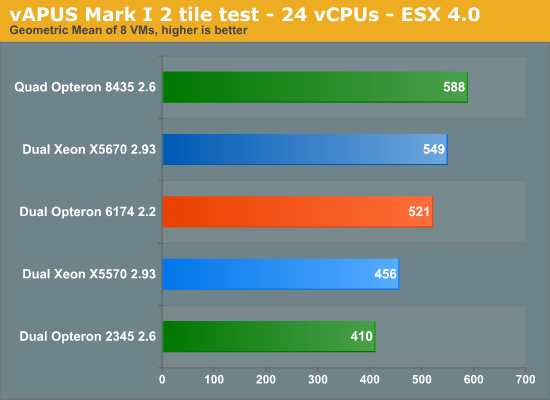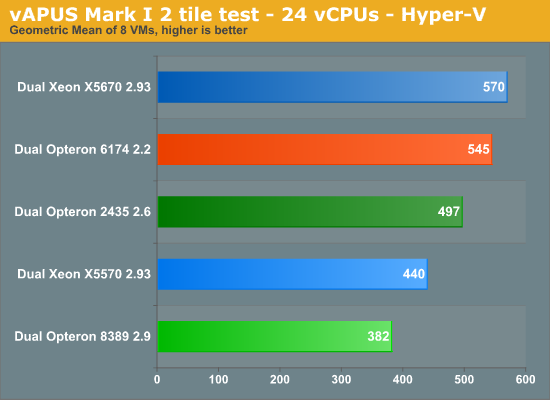AMD's 12-core "Magny-Cours" Opteron 6174 vs. Intel's 6-core Xeon
by Johan De Gelas on March 29, 2010 12:00 AM EST- Posted in
- IT Computing
vApus Mark I: Performance-Critical Applications Virtualized
Our vApus Mark I benchmark is not a VMmark replacement. It is meant to be complimentary: while VMmark uses runs 60 to 120 light loads, vApus Mark I runs 8 heavy VMs on 24 virtual CPUs (vCPUs). Our current vApus Stressclient is being improved to scale to much higher amount of vCPUs, but currently we limit the benchmark to 24 virtual CPUs.
A vApus Mark I tile consists of one OLTP, one OLAP and two heavy websites are combined in one tile. These are the kind of demanding applications that still got their own dedicated and natively running machine a year ago. vApus Mark I shows what will happen if you virtualize them. If you want to fully understand our benchmark methodology: vApus Mark I has been described in great detail here. We have changed only one thing compared to our original benchmarking: we used large pages as it is generally considered as a best practice (with RVI, EPT).
The current vApus Mark I uses two tiles. Per tile we have 4 VMs with 4 server applications:
- A SQL Server 2008 x64 database running on Windows 2008 64-bit, stress tested by our in-house developed vApus test (4 vCPUs).
- Two heavy duty MCS eFMS portals running PHP, IIS on Windows 2003 R2, stress tested by our in house developed vApus test (each 2 vCPUs).
- One OLTP database, based on Oracle 10G Calling Circle benchmark of Dominic Giles (4 vCPUs).
The beauty is that vApus (stress testing software developed by the Sizing Servers Lab) uses actions made by real people (as can be seen in logs) to stress test the VMs, not some benchmarking algorithm.
Update: We have noticed that the CPU load of Magny-cours is at 70-85%, while the Six-core "Istanbul" is running at 80-95%". As we have noted before, 24 cores is at the limit of our current benchmark until we launch vApus Mark 2. We have reason to believe that the opteron 6174 has quite a bit of headroom left. The results above are not wrong, but do not show the full potential of the 6174. We are checking the CPU load numbers of the six-core Xeon X5670 as we speak. Expect an update in the coming days.

The AMD Opteron 6174 performs well here, but disappoints a bit at the same time. vApus Mark I does not scale as well as VMmark. The reason is simple: as we used 4 virtual CPUs for both the OLTP as the OLAP virtual machine, scaling depends more on the individual applications. One VM with 4 virtual CPUs will not scale as well as 16 VMs sharing the same 4 virtual CPUs. Also, we use heavy database applications that typically like a decent amount of cache. The difference with the Xeon X5670 is small though. Servers based on both CPUs will make excellent virtualization platforms.
Next, the same test with Hyper-V, the hypervisor beneath Windows 2008 R2. We are testing with Hyper-V R2 6.1.7600.16385 (21st of July 2009).

Based on the excellent results of the Dual Opteron 2435 we expected AMD to take the crown in this benchmark, but that did not happen. We only had one week to get all of the Opteron testing done (AMD didn't have any hardware until the last minute), so we could not analyze this in depth. For some reason, the Opteron 6174 does not scale very well in our vApus benchmark. Compared to a 2.2GHz six-core, we only see a 30% increase in performance, about the same as Intel gets out of adding 2 extra cores to their Xeon. Part of the reason might be our benchmark: at the moment we are limited to 24 CPUs. We’ll investigate this in more detail in the coming quarter when vApus v2 is available.
The difference with the Xeon X5670 is small though, and the slightly lower price of the Opteron makes up for the slightly lower performance.










58 Comments
View All Comments
wolfman3k5 - Monday, March 29, 2010 - link
Great review! Thanks for the review, when will you guys be reviewing the AMD Phenom II X6 for us mere mortals? I wonder how the Phenom II X6 will stack up against the Core i7 920/930.Keep up the good work!
ash9 - Tuesday, March 30, 2010 - link
Since SSE4.1,SSE4.2 are not in AMD's , its Andand's way of getting an easy benchmark win, seeing some of these benchmark test probably use them-http://blogs.zdnet.com/Ou/?p=719
August 31st, 2007
SSE extension wars heat up between Intel and AMD
"Microprocessors take approximately five years to go from concept to product and there is no way Intel can add SSE5 to their Nehalem product and AMD can’t add SSE4 to their first-generation 45nm CPU “Shanghai” or their second-generation 45nm “Bulldozer” CPU even if they wanted to. AMD has stated that they will implement SSE4 following the introduction of SSE5 but declined to give a timeline for when this will happen."
asH
mariush - Tuesday, March 30, 2010 - link
One of the best optimized and multi threaded applications out there is the open source video encoder x264.Would it be possible to test how well 2 x 8 and 2x12 amd configurations work at encoding 1080p video at some very high quality settings?
A workstation with 24 cores from AMD would cost almost as much as a single socket 6 cores system from Intel so it would be interesting to see if the increase in frequency and the additional SSE instructions would be more advantage than the number of cores.
Aclough - Tuesday, March 30, 2010 - link
I wonder if the difference between the Windows and Linux test results is related to the recentish changes in the scheduler? From what I understand the introduction of the CFS in 2.6.23 was supposed to be really good for large numbers of cores, and I'm given to understand that before that the Linux scheduler worked similarly to the recent Windows one. It would be interesting to try running that benchmark with a 2.6.22 kernel or one with the old O(1) patched in.Or it could just be that Linux tends to be more tuned for throughput whereas Windows tends to be more tuned for low latency. Or both.
Aclough - Tuesday, March 30, 2010 - link
In any event, the place I work for is a Linux shop and our workload is probably most similar to Blender, so we're probably going to continue to buy AMD.ash9 - Tuesday, March 30, 2010 - link
http://www.egenera.com/pdf/oracle_benchmarks.pdf"Performance testing on the Egenera BladeFrame system has demonstrated that the platform
is capable of delivering high throughput from multiple servers using Oracle Real Application
Clusters (RAC) database software. Analysis using Oracle’s Swingbench demonstration tool
and the Calling Circle schema has shown very high transactions-per-minute performance
from single-node implementations with dual-core, 4-socket SMP servers based on Intel and
AMD architectures running a 64-bit-extension Linux operating system. Furthermore, results
demonstrated 92 percent scalability on either server type up to at least 10 servers.
The BladeFrame’s architecture naturally provides a host of benefits over other platforms
in terms of manageability, server consolidation and high availability for Oracle RAC."
nexox - Tuesday, March 30, 2010 - link
It could also be that Linux has a NUMA-aware scheduler, so it'd try to keep data stored in ram which is connected to the core that's running the thread which needs to access the data. I probably didn't explain that too well, but it'd cut down on memory latency because it would minimize going out over the HT links to fetch data. I doubt that Windows does this, given that Intel hasn't had NUMA systems for very long yet.I sort of like to see more Linux benchmarks, since that's really all I'd ever consider running on data center-class hardware like this, and since apparently Linux performance has very little to do with Windows performance, based on that one test.
yasbane - Wednesday, May 19, 2010 - link
Agreed. I do find it disappointing that they put so few benchmarks for Linux for servers, and so many for windows.-C
jbsturgeon - Tuesday, March 30, 2010 - link
I like the review and enjoyed reading it. I can't help but feel the benchmarks are less a comparison of CPU's and more a study on how well the apps can be threaded as well as the implementation of that threading -- higher clocked cpus will be better for serial code and more cores will win for apps that are well threaded. In scientific number crunching (the code I write ), more cores always wins (AMD). We do use Fluent too, so thanks for including those benchamarks!!jbsturgeon - Tuesday, March 30, 2010 - link
Obviously that rule can be altered by a killer memory bus :-).